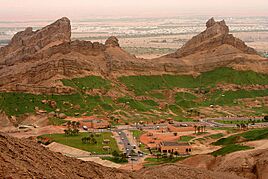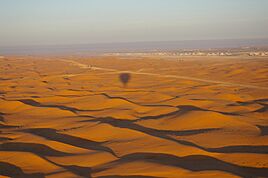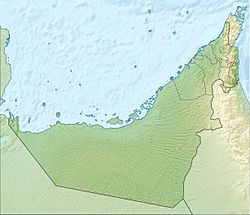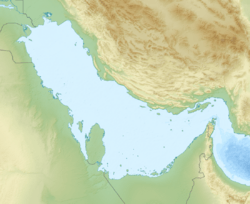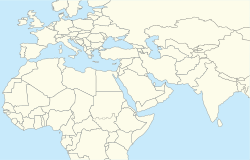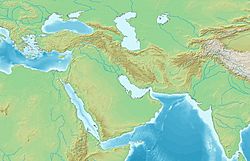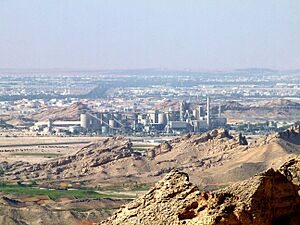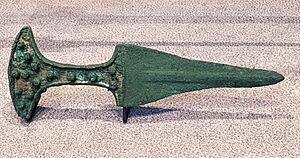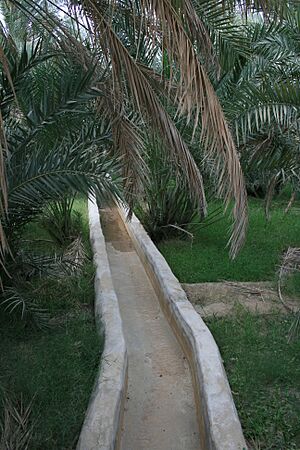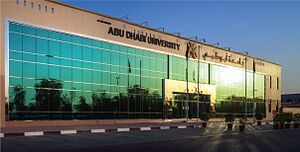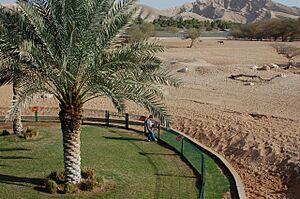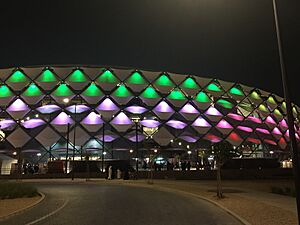Al Ain facts for kids
Quick facts for kids
Al Ain
Al-ʿAyn (ٱلْعَيْن)
|
|
|---|---|
|
Clockwise, from top: Green Mubazzarah, Sheikha Salama Mosque, the neighbouring desert, the campus of Abu Dhabi University, and Qasr Al Muwaiji
|
|
| Nickname(s): | |
| Country | |
| Emirate | |
| Municipal region | Al-Ain |
| Subdivisions |
Al Jimi
Al Qattara Al Muawiji Al Mutaredh Al Towayya Al Foah Al Masoudi Al Khrair Al Sarooj Hili Falaj Hazza Zakher Al Maqam Sh'ab Al Ashkher Al Khalidiya Al Shoaibah Al Bateen Al Agabiyya Al Khabisi Al Markhaniya Ne'mah Al Niyadat Al Kuwaitat Al Jahli Al Salamat Al Yahar Mezyad Al Dhahir Um Ghafah Oud Al Tobah Al Hiyar Nahil Sweihan Al Sadd Rimah Al Khazna Al Arad Al Dhahrah Al Manaseer Al Basrah Al Wagan Al Qoua Al Mutraid Al Kharis Al Amarah Al Salamt |
| Government | |
| • Type | Absolute monarchy |
| • Body | Al Ain City Municipality |
| Area | |
| • Total | 15,123 km2 (5,839 sq mi) |
| Elevation | 292 m (958 ft) |
| Population
(2021)
|
|
| • Total | 846,747 |
| • Density | 55.9907/km2 (145.015/sq mi) |
| GDP | |
| • Total | US$ 38.0 billion (2023) |
| • Per capita | US$ 58,900 (2023) |
| Time zone | UTC+4 (UAE Standard Time) |
| UNESCO World Heritage Site | |
| Official name | Cultural Sites of Al Ain (Hafit, Hili, Bidaa Bint Saud and Oases Areas) |
| Criteria | Cultural: iii, iv, v |
| Inscription | 2011 (35th Session) |
Al Ain (Arabic: ٱلْعَيْن, al-ʿayn, meaning "the spring") is a big city in the Emirate of Abu Dhabi, United Arab Emirates. It's the main city of the Al Ain Region. To the east, Al Ain shares a border with the Omani town of Al-Buraimi.
Al Ain is the largest city in the UAE that is not on the coast. It is the fourth-largest city in the country, after Dubai, Abu Dhabi, and Sharjah. It is also the second-largest city in the Emirate of Abu Dhabi. Al Ain, Abu Dhabi, and Dubai form a triangle, with each city about 130 kilometers (80 miles) from the others.
Contents
Climate and Geography of Al Ain
Al Ain is often called the "Garden City" of Abu Dhabi or the UAE. This is because it has lots of green spaces, like oases, parks, and tree-lined streets. New buildings in Al Ain are not allowed to be taller than seven floors. This rule helps keep the city green and open.
The city is about 160 kilometers (100 miles) east of Abu Dhabi and 120 kilometers (75 miles) south of Dubai. The eastern part of the region covers about 13,100 square kilometers (5,058 square miles). Oman is to the east, Dubai and Sharjah are to the north, and Abu Dhabi is to the west. To the south, you'll find the Empty Quarter desert and Saudi Arabia.
Mountains and Deserts Near Al Ain
The land around Al Ain is very interesting and changes as you go east. Jebel Hafeet ("Mount Hafeet") is a famous mountain just south of the city. It is part of the Hajar Mountains. Jebel Hafeet is one of the tallest mountains in the UAE, rising to about 1,100 to 1,400 meters (3,600 to 4,600 feet). It has ridges that reach into the city, like Jabal Al Naqfah and the Western ridge. North and east of Al Ain, you can see red sand dunes. The red color comes from iron oxide in the sand.
Weather in Al Ain
Al Ain has a hot desert climate. This means it has very long, extremely hot summers and warm winters. The average rainfall in Al Ain is about 96 millimeters (3.8 inches) per year. The air is often dry, especially in summer. This dry air makes Al Ain a popular place for people to visit during the hot months.
| Climate data for Al Ain International Airport (1991–2020) | |||||||||||||
|---|---|---|---|---|---|---|---|---|---|---|---|---|---|
| Month | Jan | Feb | Mar | Apr | May | Jun | Jul | Aug | Sep | Oct | Nov | Dec | Year |
| Record high °C (°F) | 31.8 (89.2) |
36.6 (97.9) |
42.9 (109.2) |
44.4 (111.9) |
49.3 (120.7) |
49.4 (120.9) |
49.2 (120.6) |
48.8 (119.8) |
47.8 (118.0) |
43.7 (110.7) |
37.5 (99.5) |
35.0 (95.0) |
49.4 (120.9) |
| Mean daily maximum °C (°F) | 24.7 (76.5) |
27.5 (81.5) |
31.3 (88.3) |
36.9 (98.4) |
42.1 (107.8) |
44.6 (112.3) |
44.9 (112.8) |
44.6 (112.3) |
42.0 (107.6) |
37.7 (99.9) |
31.4 (88.5) |
26.9 (80.4) |
36.2 (97.2) |
| Daily mean °C (°F) | 18.5 (65.3) |
20.7 (69.3) |
24.0 (75.2) |
29.1 (84.4) |
33.7 (92.7) |
36.0 (96.8) |
37.2 (99.0) |
37.1 (98.8) |
34.4 (93.9) |
30.3 (86.5) |
24.8 (76.6) |
20.4 (68.7) |
28.9 (84.0) |
| Mean daily minimum °C (°F) | 12.8 (55.0) |
14.5 (58.1) |
17.3 (63.1) |
21.7 (71.1) |
25.7 (78.3) |
28.1 (82.6) |
30.2 (86.4) |
30.6 (87.1) |
27.6 (81.7) |
23.7 (74.7) |
19.0 (66.2) |
14.8 (58.6) |
22.2 (72.0) |
| Record low °C (°F) | 5.6 (42.1) |
5.9 (42.6) |
9.9 (49.8) |
13.2 (55.8) |
18.0 (64.4) |
19.9 (67.8) |
22.8 (73.0) |
21.9 (71.4) |
21.8 (71.2) |
16.2 (61.2) |
13.0 (55.4) |
7.4 (45.3) |
5.6 (42.1) |
| Average precipitation mm (inches) | 14.7 (0.58) |
4.6 (0.18) |
17.9 (0.70) |
6.1 (0.24) |
0.7 (0.03) |
0.6 (0.02) |
4.9 (0.19) |
1.5 (0.06) |
0.8 (0.03) |
0.5 (0.02) |
2.2 (0.09) |
7.3 (0.29) |
62.0 (2.44) |
| Average precipitation days (≥ 1 mm) | 3.2 | 2.0 | 2.6 | 1.7 | 1.0 | 1.5 | 1.4 | 1.2 | 1.2 | 1.0 | 1.3 | 1.8 | 20.0 |
| Average relative humidity (%) | 63 | 55 | 48 | 36 | 30 | 33 | 37 | 35 | 39 | 43 | 53 | 61 | 44 |
| Average dew point °C (°F) | 10 (50) |
10 (50) |
10 (50) |
10 (50) |
12 (54) |
16 (61) |
18 (64) |
18 (64) |
16 (61) |
15 (59) |
14 (57) |
11 (52) |
13 (56) |
| Source 1: NOAA | |||||||||||||
| Source 2: Time and Date (dewpoints, between 2005 and 2015) | |||||||||||||
South of the city, near Oman, there is a man-made lake called Lake Zakher. This lake was created from water released by desalination plants. Also in this area, east of Jebel Hafeet, is Mezyad. Mezyad has a border crossing with Oman and is home to the historic Mezyad Fort.
People Living in Al Ain
Al Ain has a population of about 766,936 people (as of 2017). It has the highest percentage of Emirati citizens in the country, about 30.8%. However, most of the people living in Al Ain are from other countries, especially from the Indian subcontinent. Many residents come from Bangladesh, Pakistan, and Afghanistan.
Economy and Business in Al Ain
Al Ain is an important center for services for a large area, including parts of Oman. The city has several big shopping malls, like Al Ain Mall, Al Jimi Mall, and Al Bawadi Mall. There are also traditional markets called souqs where you can buy fruits, vegetables, and even livestock. One special souq is for camels, located near an IKEA store and Bawadi Mall.
Some industries are growing in Al Ain, such as a Coca-Cola bottling plant and the Al Ain Portland Cement Works. The water in Al Ain is known to be of good quality. Services like car sales and mechanics are found in the Sanaiya area. Al Ain is also home to Al Foah Company LLC, which is the world's largest company for processing and selling dates. The city is also known for the Al Ain Dairy Farm.
History of Al Ain
The area of Al Ain and Buraimi, together called the Buraimi Oasis, is very important for its culture and history. This region has seen many historical events, including those related to the early days of Islam. Sheikh Zayed bin Sultan Al Nahyan, who founded the United Arab Emirates, spent a lot of his life here. He lived in Al Ain from about 1927 until he became the Ruler of Abu Dhabi in 1966. Some people believe he was born in Al Ain. The city might also have the oldest mosque in the UAE, located at the Sheikh Khalifa Mosque.
Ancient Times in Al Ain
People have lived in the Al Ain area for almost 8,000 years. Archaeologists have found signs of ancient settlements at places like Rumailah, Hili, and Jabel Ḥafeet. The early Hafit culture built unique "beehive" tombs for their dead. They hunted and gathered food in the area. The oases provided water for early farms.
In the 1950s, Sheikh Zayed found these tombs. He told a team from Denmark about them, and they started digging in 1959. In 1971, the Al Ain Museum was built to display items found in this area. In 2011, Al Ain became the first World Heritage Site in the UAE to be recognized by UNESCO.
Ancient burial sites often reused materials from older burials. For example, a tomb from the Wadi Suq culture at Qattara Oasis might have been built with stones from even older burials.
Discoveries at Qattara include jugs and bowls from the Wadi Suq era, and short swords and daggers from the late Bronze Age. Jewelery made of carnelian has also been found. This type of jewelery suggests that Al Ain traded with the Indus Valley civilisation. An interesting find from Qattara is a Bronze Age pendant from the 1970s. It shows two horned animals joined together. This design is found in other Bronze Age sites in the UAE.
In the Iron Age, people in Al Ain and Buraimi used aflaj (underground water channels) for irrigation. These channels were built centuries before similar systems in other parts of the world.
Recent History and Development
Al Ain was originally influenced by the Dhawahir, a Bedouin tribe. Later, another tribe called the Na'im also lived there, and the two tribes often had disagreements. The Bani Yas of Abu Dhabi, led by Sheikh Zayed bin Khalifa Al Nahyan (known as 'Zayed the Great'), gained control over Al Ain. In 1877, he built a fort, Al Jahili Fort, to show his power over the oasis.
Wilfred Thesiger, a famous explorer, visited Al Ain in the late 1940s. He met Sheikh Zayed and stayed with him at Al Muwaiji Fort. There was a disagreement over the border between Saudi Arabia, Abu Dhabi, and Oman, which led to the Buraimi Dispute. British forces helped resolve the issue, and the oasis returned to Abu Dhabi and Oman.
In 1971, Queen Elizabeth II visited Al Ain. After the UAE became independent in 1971, Al Ain grew very quickly. It became much larger and more successful than Oman's Al-Buraimi. In 1972, Oman and Abu Dhabi agreed on the final borders between Buraimi and Al Ain. Until Sheikh Zayed passed away in 2004, buildings in Al Ain were generally limited to four stories high. In 2006, the open border between Buraimi and Al Ain was closed, and passport checks were put in place.
Oases and Water Systems
Al Ain is famous for its wāḥāt (oases). These oases use an ancient underground irrigation system called falaj or qanāt. This system brings water from underground to water farms and palm trees. Falaj irrigation has been used for thousands of years in places like Oman, the UAE, China, and Iran.
There are seven oases in Al Ain:
- Al Ain Oasis (the largest)
- Al-Jahili Oasis (the smallest)
- Al Qattara
- Al-Muʿtaredh
- Al-Jimi
- Al-Muwaiji
- Hili
An example of a falaj is Falaj Hazza, named after Sheikh Zayed's older brother, Hazza bin Sultan Al Nahyan. There is even a district named after it.
City Life and Buildings
Al Ain has a mix of modern and older buildings. The older buildings show the city's rich cultural heritage. In the past, the city had many roundabouts, but now most intersections use traffic lights.
Learning and Education
Al Ain is home to the main federal university in the UAE, the United Arab Emirates University. It also has two campuses of the Higher Colleges of Technology for men and women. Horizon International flight academy, which trains pilots for Etihad Airways, is also located here. Other private universities include Al Ain University and the Al Ain campus of Abu Dhabi University. The city also has the eastern zone headquarters for the Abu Dhabi Department of Education and Knowledge.
Many private schools for children of people from other countries are in the Al-Manaseer area. These include Al-Ain International School, Al Ain English Speaking School, and International School of Choueifat. The Zayed Central Library was opened in 1977.
Places of Worship
The largest mosque in Al Ain used to be the Sheikha Salama Mosque. In 2021, the Sheikh Khalifa Grand Mosque became the biggest mosque in the city. It is also one of the largest mosques in the country.
Getting Around Al Ain
Al Ain is connected to Al Faqa' and Dubai in the north by the Dubai–Al-Ain Road. This road also links to Al Madam in the Emirate of Sharjah. The city is connected to Abu Dhabi in the west, Al-Qu'a in the southeast, and Mezyad in the southwest. You can travel between these areas by bus and taxi. The southern border area of Mezyad is on the road to Dhank, Ibri, and Nizwa in Oman. The city's airport (Al Ain International Airport) has flights to Egypt, Pakistan, and India. A new railway line is being planned to connect Al Ain to Abu Dhabi and to the Port of Sohar in Oman.
Fun Things to Do in Al Ain
Al Ain is becoming a popular place for tourists. Its dry desert air offers a nice break from the humid air of coastal cities. Many Emirati families from Abu Dhabi have holiday homes here, making it a favorite weekend spot.
Some popular attractions include:
- The Al Ain National Museum
- The Al Ain Palace Museum
- Restored forts
- The Hili Archaeological Park (an ancient site from the Bronze Age)
Jebel Hafeet mountain is a major landmark. People enjoy visiting the mineral springs at Green Mubazzarah at the base of the mountain. Driving to the mountaintop at sunset is also very popular. Other fun places are the Al Ain Zoo, the "Hili Fun City" amusement park, and many parks perfect for families.
Opened in 2012, Wadi Adventure is near Jebel Hafeet. It offers many water activities like surfing, kayaking, and rafting. The Mercure Hotel is located on top of Jebel Hafeet. Mount Hafeet and its nearby "beehive" tombs are part of the "Jebel Hafeet Desert Park". This park helps protect nature and geology while attracting visitors.
Al Ain has five main shopping malls: Al Ain Mall, Al-Jimi Mall, Bawadi Mall, Remal Mall, and Hili Mall. Most of the city's shopping is in the town center.
Many Emiratis and people from other countries enjoy spending time at coffee shops and shisha cafes. Al Ain has strict rules about alcohol, similar to the rest of the UAE. The city also has an international standard go-kart track.
Al Ain has two English radio stations: 100.1 Star FM, which plays English and Arabic hits, and 105.2 Abu Dhabi Classic FM, which plays classical music.
Sports, Culture, and Arts in Al Ain
Al Ain is a cultural escape for people from Dubai and Abu Dhabi. It hosts a big classical music festival. It is also home to Al Ain Football Club, one of the most successful football clubs in the UAE and Asia. The Al Ain Club also has teams for handball, volleyball, basketball, swimming, table tennis, athletics, jiu-jitsu, and taekwondo. The Al Ain Amblers are a well-known rugby club with teams for men, women, and juniors.
Hili Fun City has two ice hockey teams, the Al Ain Vipers and Ghantoot. Both teams have adult and youth players, starting from age 4. The Al-Ain Vipers Men's Team won the Emirates Hockey League in the 2009–10 season.
The Palm Resort has a popular rugby club and the Al-Ain International Soccer Club, which has three youth teams. "Wadi Adventure" is a water sports center with a wave pool and instructors for surfing, kayaking, and rafting on an artificial river.
Images for kids
-
Dromedaries at the city's Camel Market. The camel is important to the cultures of Arabia, the Middle East, and elsewhere.
-
Jebel Hafeet, as viewed from Mezyad Fort near the southern border with Al Buraimi Governorate in Oman
-
Qasr Al Muwaiji, the birthplace of Sheikh Khalifa bin Zayed Al Nahyan, the former Ruler of Abu Dhabi and President of the UAE, and former home of his father, Sheikh Zayed
See also
 In Spanish: Al Ain para niños
In Spanish: Al Ain para niños


